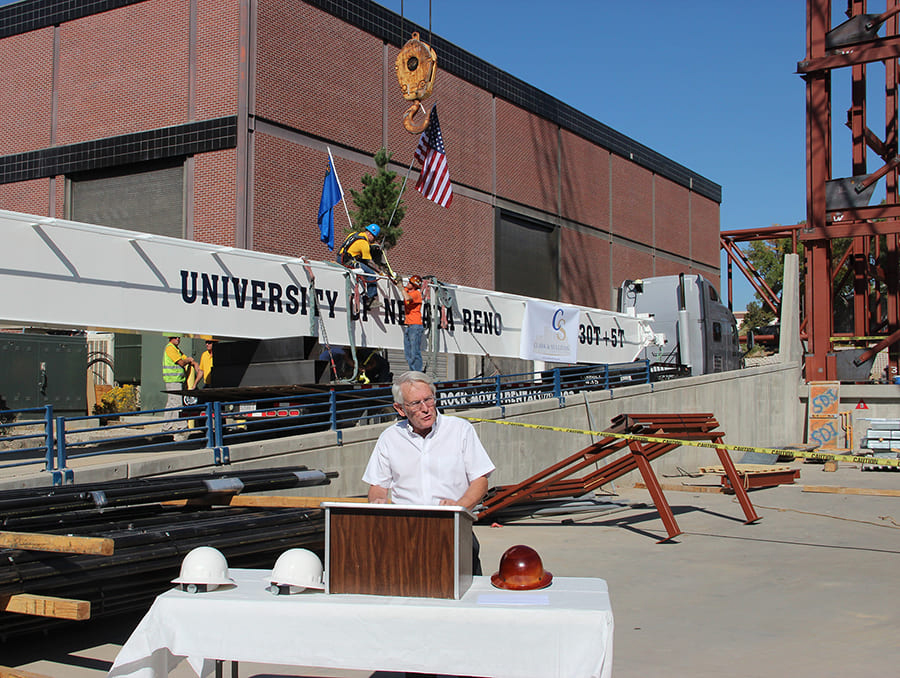Construction of a 24,500-square-foot addition to the College of Engineering's earthquake engineering simulation laboratory has been non-stop over the past several months, complete with the roaring sound of diesel machinery and the sight of hard hat-wearing workers in constant motion.
All of the activity, at least for a few minutes anyway, came to a well-earned halt on Thursday morning as a "topping-out" ceremony was held.
As dozens of spectators looked on, a white, 30-ton, 90-foot-long bridge crane - which itself hosted a small pine tree along with a U.S. and state of Nevada flag - was placed at the top of the structure.
The "topping-out" ceremony signified completion of the steel-setting portion of the $18 million expansion project.
"It's a very exciting day for us," said Manos Maragakis, dean of the College of Engineering. Maragakis noted that the facility, when it is completed in about a year, will offer University of Nevada, Reno students "a state-of-the-art facility to make them globally competitive."
Just as importantly, Maragakis added, the facility, which is scheduled to open in September 2013, will be "the biggest and most versatile earthquake facility in the nation, and in many respects, in the world."
The expansion is part of the world-renowned work done at the University's Large-Scale Structures Lab at the Center for Civil Engineering Research.
Ian Buckle, direct of the center, said that construction, from a distance, has seemed to pick up in recent weeks, though work has been ongoing for quite some time. He said it is the nature of the building, which will host large-scale "shake tables" for earthquake engineering research, that explains why. He said more than 6,000 tons of concrete need to be poured before several hundred thousand of tons of steel for the building could even be erected.
"There will be nowhere else in the world quite like this," Buckle said. "I don't think anyone will catch up anytime soon."
In about six months, shake tables will be moved from the existing large-scale structures lab, and by September will be fully operational as the University continues its strong national and international research agenda for finding ways to make large scale structures safer.
"This is a very unique facility and probably the only one of its kind in the world when it's finished," Buckle said, adding that the expansion will allow the University's research to diversify its range for the study of taller and wider buildings, for example.
The project also has a key impact on the economy, said B.J. Sullivan, president of the project's contractor, Clark and Sullivan Construction Company. Sullivan said 76 percent of the project's subcontractors and suppliers were from Reno, that 88 percent were from Nevada, and that 94 percent of the $11.1 million contract was going to Nevada companies.
"Which is a good deal," Sullivan said.
Even during Thursday's ceremony, which took about an hour, there was little rest for the workers. Engines were turned off for a few moments to allow the special guests to speak, but even then, a group of a half-dozen workers were busy preparing the white bridge crane with the tonnage (30T + 5T) printed in bold blue numbers on the side, along with the words "UNIVERSITY OF NEVADA RENO," for lifting atop the mass of rust-colored steel beams.
Once the bridge crane was hoisted into place by a massive yellow Bragg crane, and after the local television stations had finished capturing footage and conducting interviews with the principal players and the complimentary hard hats given to visitors were returned to boxes, the machinery and the workers of the project wasted very little time.
The site of one of the University's most important research facility projects was back to work.











